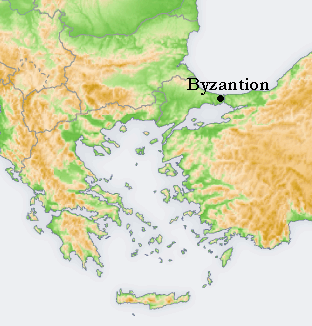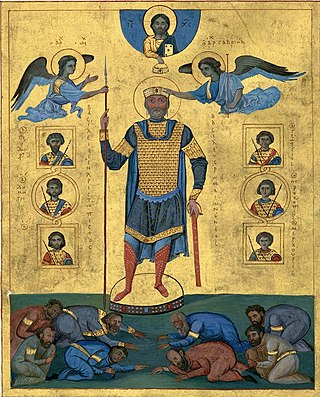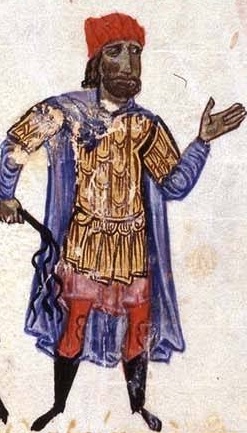
Byzantium or Byzantion was an ancient Greek city in classical antiquity that became known as Constantinople in late antiquity and Istanbul today. The Greek name Byzantion and its Latinization Byzantium continued to be used as a name of Constantinople sporadically and to varying degrees during the thousand year existence of the Byzantine Empire. Byzantium was colonized by Greeks from Megara in the 7th century BC and remained primarily Greek-speaking until its conquest by the Ottoman Empire in AD 1453.

Basil II Porphyrogenitus, nicknamed the Bulgar Slayer, was the senior Byzantine emperor from 976 to 1025. He and his brother Constantine VIII were crowned before their father Romanos II died in 963, but they were too young to rule. The throne thus went to two generals, Nikephoros Phokas and John Tzimiskes before Basil became senior emperor, though his influential great-uncle Basil Lekapenos remained as the de facto ruler until 985. His reign of 49 years and 11 months was the longest of any Roman emperor.

Constantine VIII Porphyrogenitus was de jure Byzantine emperor from 962 until his death. He was the younger son of Emperor Romanos II and Empress Theophano. He was nominal co-emperor since 962, successively with his father; stepfather, Nikephoros II Phokas; uncle, John I Tzimiskes; and brother, Basil II. Basil's death in 1025 left Constantine as the sole emperor. He occupied the throne for 66 years in total, making him de jure the longest-reigning amongst all Roman emperors since Augustus.

Basil I, nicknamed "the Macedonian", was Byzantine emperor from 867 to 886. Born a lowly peasant in the theme of Macedonia, he rose to prominence in the imperial court after entering into the service of Theophilitzes, a relative of Emperor Michael III. He was given a fortune by the wealthy Danielis and gained Michael's favour, whose mistress he married on his emperor's orders. In 866, Michael proclaimed him co-emperor, but Basil ordered his assassination the next year, thus installing himself as sole ruler of the empire. Despite his humble origins, he showed great ability in running the affairs of state, and founded the Macedonian dynasty. He was succeeded upon his death by his son Leo VI.

Leo V the Armenian was the Byzantine emperor from 813 to 820. A senior general, he forced his predecessor, Michael I Rangabe, to abdicate and assumed the throne. He ended the decade-long war with the Bulgars, and initiated the second period of Byzantine Iconoclasm. He was assassinated by supporters of Michael the Amorian, one of his most trusted generals, who succeeded him on the throne.

Irene of Athens, surname Sarantapechaena, was Byzantine empress consort to Emperor Leo IV from 775 to 780, regent during the childhood of their son Constantine VI from 780 until 790, co-ruler from 792 until 797, and finally empress regnant and sole ruler of the Eastern Roman Empire from 797 to 802. A member of the politically prominent Sarantapechos family, she was selected as Leo IV's bride for unknown reasons in 768. Even though her husband was an iconoclast, she harbored iconophile sympathies. During her rule as regent, she called the Second Council of Nicaea in 787, which condemned iconoclasm as heretical and brought an end to the first iconoclast period (730–787). Her public figure was very polarizing during her 5 year reign, as most saw it as wrong for a woman to rule solely. Her reign as such made her the first ever empress regnant, ruling in her own right, in Roman and Byzantine imperial history.

Theodora Porphyrogenita was Byzantine Empress from 21 April 1042 to her death on 31 August 1056, and sole ruler from 11 January 1055. She was the last sovereign of the Macedonian dynasty, that ruled the Eastern Roman Empire for almost 200 years.

Constantine V was Byzantine emperor from 741 to 775. His reign saw a consolidation of Byzantine security from external threats. As an able military leader, Constantine took advantage of civil war in the Muslim world to make limited offensives on the Arab frontier. With this eastern frontier secure, he undertook repeated campaigns against the Bulgars in the Balkans. His military activity, and policy of settling Christian populations from the Arab frontier in Thrace, made Byzantium's hold on its Balkan territories more secure.

Constantine VI was Byzantine emperor from 780 to 797. The only child of Emperor Leo IV, Constantine was named co-emperor with him at the age of five in 776 and succeeded him as sole Emperor in 780, aged nine. His mother Irene exercised control over him as regent until 790, assisted by her chief minister Staurakios. The regency ended when Constantine reached maturity, but Irene sought to remain an active participant in the government. After a brief interval of sole rule Constantine named his mother empress in 792, making her his official colleague.

Leo VI, called the Wise, was Byzantine Emperor from 886 to 912. The second ruler of the Macedonian dynasty, he was very well read, leading to his epithet. During his reign, the renaissance of letters, begun by his predecessor Basil I, continued; but the empire also saw several military defeats in the Balkans against Bulgaria and against the Arabs in Sicily and the Aegean. His reign also witnessed the formal discontinuation of several ancient Roman institutions, such as the separate office of Roman consul.

George Maniakes was a prominent general of the Byzantine Empire during the 11th century. He was the catepan of Italy in 1042. He is known as Gyrgir in Scandinavian sagas. He is popularly said to have been extremely tall and well built, almost a giant.
Louis the Blind was the king of Provence from 11 January 887, King of Italy from 12 October 900, and briefly Holy Roman Emperor, as Louis III, between 901 and 905. His father was a Bosonid and his mother was a Carolingian. He was blinded after a failed invasion of Italy in 905.
Scaphism, also known as the boats, is an alleged ancient Persian method of execution mentioned by Plutarch in his Life of Artaxerxes. It ostensibly entailed trapping the victim between two boats, feeding and covering them with milk and honey, and allowing them to fester and be devoured by insects and other vermin over time.
Ermengard of Italy was Queen of Provence as the spouse of King Boso. She was the second and only surviving child of Emperor Louis II. In her early life, she was betrothed to Constantine, the junior Byzantine emperor, but whether the marriage actually occurred or not is still debated among historians. In 871, Ermengard and her family were taken hostage by Adelchis of Benevento but were later freed. In 876, Ermengard married Boso, a nobleman with connections to the Carolingian dynasty, and became queen upon his accession to the throne of Provence in 879. After her husband's death in 887, she served as regent of the kingdom during the minority of her son Louis the Blind.

The Byzantine Empire was ruled by the Isaurian dynasty from 717 to 802. The Isaurian emperors were successful in defending and consolidating the empire against the caliphates after the onslaught of the early Muslim conquests, but were less successful in Europe, where they suffered setbacks against the Bulgars, had to give up the Exarchate of Ravenna, and lost influence over Italy and the papacy to the growing power of the Franks.
Staurakios was a Byzantine Greek eunuch official, who rose to be one of the most important and influential associates of Byzantine empress Irene of Athens. He effectively acted as chief minister during her regency for her young son, Emperor Constantine VI in 780–790, until overthrown and exiled by a military revolt in favour of the young emperor in 790. Restored to power by Constantine along with Irene in 792, Staurakios aided her in the eventual removal, blinding, and possible murder of her son in 797. His own position thereafter was threatened by the rise of another powerful eunuch, Aetios. Their increasing rivalry, and Staurakios's own imperial ambitions, were only resolved by Staurakios's death.
Nikephoros, also Latinized as Nicephorus, was the second son of Byzantine emperor Constantine V and Caesar of the Byzantine Empire. He was engaged in a plot against his half-brother, Leo IV, which cost Nikephoros his title, and was the focal point of numerous usurpation plots during the subsequent reigns of his nephew, Constantine VI, and of Constantine's mother, Irene of Athens. He was therefore blinded and exiled to a monastery for most of his life, probably dying in the island of Aphousia sometime after 812.
Michael Lachanodrakon was a distinguished Byzantine general and fanatical supporter of Byzantine Iconoclasm under Emperor Constantine V. As a result of his iconoclast zeal, in 766 he rose to high office as governor of the Thracesian Theme, and instigated a series of repressive measures against iconophile practices, particularly targeting the monasteries. A talented general, he also led a series of campaigns against the Arabs of the Abbasid Caliphate before being dismissed from office in about 782. Restored to imperial favour in 790, he fell at the Battle of Marcellae against the Bulgars in 792.

An acid attack, also called acid throwing, vitriol attack, or vitriolage, is a form of violent assault involving the act of throwing acid or a similarly corrosive substance onto the body of another "with the intention to disfigure, maim, torture, or kill". Perpetrators of these attacks throw corrosive liquids at their victims, usually at their faces, burning them, and damaging skin tissue, often exposing and sometimes dissolving the bones. Acid attacks can lead to permanent, partial, or complete blindness.

Blinding is a type of physical punishment which results in complete or nearly complete loss of vision. It was used as an act of revenge and torture. The punishment has been used since Antiquity; Greek mythology makes several references to blinding as divine punishment, which reflects human practice.












